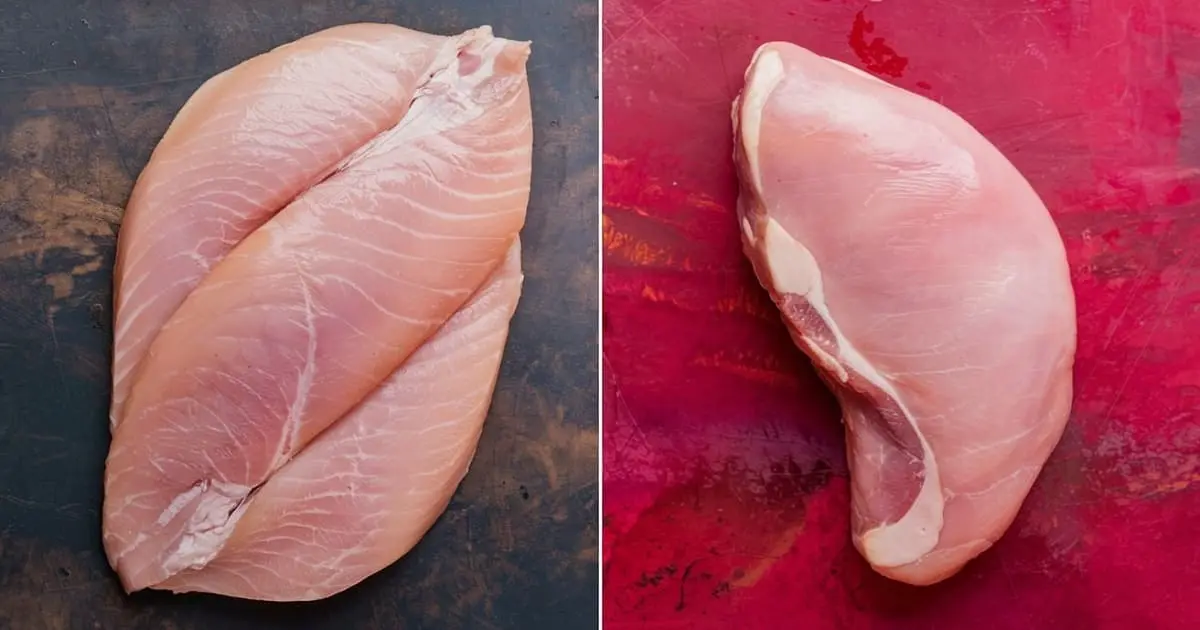Introduction
In the culinary world, the distinctions between various cuts of meat can make a significant difference in the outcome of a dish. Among the most commonly confused cuts in poultry are thin sliced chicken breast vs chicken tenderloin. Although these cuts may seem similar at first glance, they possess unique characteristics that influence their flavor, texture, and best uses in the kitchen. This article aims to dissect these differences thoroughly, providing you with the knowledge needed to choose the right cut for your recipes, ensuring that your meals are always delicious and satisfying.
Understanding the nuances between thin sliced chicken breast vs tenderloin is not only important for cooking professionals but also for home cooks who seek to elevate their dishes. By the end of this article, you’ll be equipped with a deeper knowledge of these cuts, including their nutritional content, culinary uses, and the best ways to prepare them.
What is Thin Sliced Chicken Breast?
Thin sliced chicken breast is a popular cut of poultry that is derived from the standard chicken breast. As the name suggests, this cut involves taking a whole chicken breast and slicing it into thin, even pieces. This method of preparation is particularly useful for recipes that require quick cooking times, as the thin slices cook much faster than a whole breast. Additionally, the uniformity of the slices ensures that the chicken cooks evenly, reducing the risk of undercooking or overcooking certain parts.
Thin sliced chicken breast is often favored in dishes where the chicken needs to be cooked quickly, such as stir-fries, sandwiches, and salads. The thin slices also absorb marinades and seasonings more efficiently, allowing for a more flavorful dish. Because of its versatility and ease of preparation, thin sliced chicken breast has become a staple in many households.
- Characteristics:
- Thin, uniform slices of chicken breast.
- Retains the same flavor profile as a regular chicken breast.
- Ideal for recipes requiring quick cooking.
- Absorbs marinades and seasonings effectively.
If you’re interested in learning more about thinly sliced chicken breast, consider reading this comprehensive guide on what thinly sliced chicken breast is called and how it is commonly used in cooking.
What is a Chicken Tenderloin?
Chicken tenderloin, commonly referred to as chicken tenders or strips, is a specific muscle located beneath the chicken breast. This muscle is smaller, more tender, and typically more flavorful than the breast itself. The tenderloin is a lesser-known cut, often overshadowed by the more popular breast, but it offers unique culinary advantages due to its tenderness and rich flavor.
The tenderloin is a strip of white meat that lies just beneath the breast and is attached to the breastbone by a thin membrane. This cut is naturally more tender than the breast because it contains less connective tissue, making it a preferred choice for recipes that require tender, juicy meat. Chicken tenderloins are often used in dishes where the meat needs to be particularly tender, such as in chicken tenders, skewers, or stir-fries.
- Characteristics:
- A small, tender muscle located under the chicken breast.
- Softer and more tender than the chicken breast.
- A bit more fat content enhances the flavor, making it richer.
- Ideal for dishes that require tender, easily chewable pieces of chicken.
Anatomical Differences
Understanding the anatomical differences between thin sliced chicken breast and chicken tenderloin is crucial for recognizing their unique qualities and how they impact the final dish.
- Location:
- The chicken breast is the large muscle located on the chest of the bird. This cut of chicken is widely favored for its size, versatility, and lean quality.
- The tenderloin is a smaller muscle that lies directly beneath the breast, attached by a thin membrane. This cut is less visible but can be easily separated from the breast when butchering a chicken.
- Size and Composition:
- Chicken breasts are significantly larger and thicker than tenderloins, making them suitable for a wide range of cooking methods, including grilling, roasting, and frying. Their larger size means they can be sliced, pounded, or butterflied to suit different recipes.
- Tenderloins, being smaller and thinner, cook more quickly than breasts. They are also more delicate, requiring careful handling to avoid overcooking. Their small size makes them ideal for recipes where the meat needs to be tender and moist, such as in stir-fries or skewers.
- Texture and Fiber:
- Chicken breast has a firmer texture and is slightly fibrous, which makes it ideal for dishes where a substantial bite is desired. The muscle fibers in the breast are longer and more tightly packed, giving it a chewier texture.
- Tenderloins, on the other hand, have a much softer texture with finer muscle fibers. This results in a cut of meat that is exceptionally tender and almost melts in the mouth when cooked properly.
If you’re curious about keeping thin chicken breasts moist during cooking, you might find this article helpful for additional tips.
Nutritional Differences

Nutritional content is another critical factor that sets thin sliced chicken breast apart from chicken tenderloin. Both cuts are excellent sources of lean protein, but they differ slightly in their fat content, calorie count, and other nutritional values.
- Protein Content:
- Chicken breast and tenderloin are both high in protein, which makes them great options for anyone seeking to boost their protein consumption. Generally, chicken breast has a higher protein content per serving because of its larger size.
- A standard serving of chicken breast contains approximately 31 grams of protein per 100 grams, whereas chicken tenderloin has a bit less, providing around 28 grams per 100 grams.
- Fat Content and Calories:
- Chicken tenderloins have a slightly higher fat content compared to chicken breasts. This extra fat contributes to the tenderloin’s richer flavor and juicier texture.
- While both cuts are relatively low in fat, the tenderloin’s additional fat content means it also has a slightly higher calorie count. A 100-gram serving of chicken breast contains approximately 165 calories, while the same amount of tenderloin has about 180 calories.
- Dietary Considerations:
- For those following a diet that emphasizes lean protein with minimal fat, thin sliced chicken breast is often the preferred choice. Its lower fat content makes it a staple in many diet plans focused on nutrition and well-being.
- Chicken tenderloin, with its richer flavor and juicier texture, is an excellent option for those who prioritize taste and tenderness in their meals. It is particularly suitable for dishes where the texture of the meat is paramount.
Culinary Uses and Cooking Techniques
The choice between thin sliced chicken breast vs chicken tenderloin often depends on the specific culinary application. Each cut has its unique strengths, making them ideal for different types of recipes.
- Thin Sliced Chicken Breast:
- Thin sliced chicken breast is incredibly versatile and can be used in a wide range of dishes. Its thin, even slices make it ideal for recipes that require quick cooking, such as stir-fries, sandwiches, and pan-seared dishes.
- The thinness of sliced chicken breast allows for quick and even cooking, which diminishes the likelihood of it becoming dry. It is best cooked over high heat for a short duration to maintain its moisture and flavor.
- This cut is also perfect for dishes that require marinating, as the thin slices absorb flavors quickly and evenly. Whether grilled, sautéed, or baked, thin sliced chicken breast is a reliable choice for many quick and flavorful meals.
- Chicken Tenderloin:
- Chicken tenderloin is best suited for dishes that require tender, juicy meat. Its natural tenderness makes it a popular choice for chicken tenders, skewers, and stir-fries.
- Tenderloins are often breaded and fried to create crispy, golden chicken tenders. The tenderness of the meat ensures that the interior remains juicy and flavorful, even after frying.
- When marinated, chicken tenderloins can be grilled or baked to create dishes that are both flavorful and tender. Their small size and delicate nature make them perfect for recipes that require precise cooking.
For more in-depth information on how to cook these chicken cuts, check out this guide on Joy Filled Eats. If you’re interested in understanding the anatomy of these cuts further, Real Simple provides an excellent resource on chicken cuts and their uses.
Cost Comparison

Cost is another important consideration when choosing between thin sliced chicken breast vs chicken tenderloin. While both cuts are relatively affordable, there are some differences in price that may influence your decision.
- Price Differences:
- Chicken tenderloins are often sold at a higher price per pound than chicken breasts. This is due to their smaller size and greater tenderness, which requires more precise butchering.
- Thin sliced chicken breasts, being a larger cut, are typically more affordable and are often available in bulk. This makes them a cost-effective choice for families or those who prepare meals in large quantities.
- Value for Money:
- If you are looking for cost-effectiveness, thin sliced chicken breasts offer more value due to their larger size and versatility. They can be used in a variety of dishes and can be easily portioned to suit different recipes.
- However, for dishes where tenderness and flavor are crucial, chicken tenderloins may be worth the extra expense. Their rich flavor and soft texture can elevate a dish, making them a worthwhile investment for certain recipes.
Synonyms for Dietary Considerations
Both thin sliced chicken breast vs chicken tenderloin can be part of a diet that emphasizes nutrition and well-being. For those monitoring their intake, these cuts provide options that align with various dietary goals.
- Thin sliced chicken breast is often chosen for its lower fat content, making it an excellent option for those focusing on a nutrient-dense diet.
- Chicken tenderloin offers a richer flavor, which can be an asset in dishes that require more robust taste without compromising on nutrition.
When preparing these cuts, consider pairing them with nutrient-rich vegetables and whole grains to create balanced, nourishing meals that support overall well-being.
FAQs
What is Thinly Sliced Chicken Breast Called?
Thinly sliced chicken breast is often referred to as cutlets. These are essentially chicken breasts that have been sliced horizontally to create thin, even pieces. Cutlets are commonly used in dishes that require quick cooking, such as stir-fries, sandwiches, and pan-seared meals.
Can I Substitute Chicken Breasts for Tenderloins?
Yes, chicken breasts can be substituted for tenderloins in most recipes. However, it’s important to adjust the cooking time since tenderloins cook faster due to their smaller size and tender nature. If substituting chicken breasts for tenderloins, consider slicing the breasts into thinner pieces or pounding them to a uniform thickness to ensure even cooking.
What is the Difference Between a Chicken Breast and a Chicken Tenderloin?

The primary difference between chicken breast and chicken tenderloin lies in their location on the chicken and their texture. Chicken breasts are larger and slightly firmer, making them suitable for a wide range of cooking methods. In contrast, chicken tenderloins are smaller, softer, and more tender, making them ideal for dishes where tenderness is key.
Are Chicken Tenders Just Sliced Chicken Breast?
No, chicken tenders or tenderloins are a specific muscle located under the breast. They are naturally tender and should not be confused with thinly sliced chicken breast. While both cuts are similar in flavor, the tenderloin’s soft texture sets it apart from the firmer breast.
Recipe Examples Using Both Cuts
To illustrate the versatility of these cuts, here are some example dishes:
- Thin Sliced Chicken Breast:
- Chicken Piccata: A classic dish where thin slices of chicken are quickly sautéed and served with a lemony caper sauce. The thin slices cook quickly, making this a perfect weeknight meal.
- Stir-Fry: Thin slices of chicken breast cook quickly and evenly in a hot wok, making them perfect for a quick and flavorful stir-fry. Pair with fresh vegetables and a savory sauce for a balanced meal.
- Chicken Parmesan: Bread thin slices of chicken breast and bake or fry until crispy. Top with marinara sauce and melted cheese for a comforting and satisfying dish.
- Chicken Tenderloin:
- Chicken Tenders: Breaded and fried, these make for a deliciously crispy meal. The tenderloin’s natural tenderness ensures that the interior remains juicy and flavorful.
- Chicken Skewers: Marinate tenderloins and grill them on skewers for a flavorful and tender dish. The small size of the tenderloins makes them perfect for grilling, as they cook quickly and evenly.
- Chicken Stir-Fry: Similar to thin sliced chicken breast, tenderloins can be used in stir-fries for a dish that is both tender and full of flavor. The tenderloins absorb the flavors of the sauce, making each bite delicious.
For more recipe ideas and cooking tips, explore this guide on the difference between chicken cutlets and thin sliced chicken breasts.
Conclusion
Choosing between thin sliced chicken breast vs chicken tenderloin depends largely on the specific needs of your dish. While both are excellent sources of lean protein, they each bring unique qualities to the table. Whether you prioritize tenderness, cooking time, or cost, understanding these differences will help you make informed decisions in the kitchen.
For further exploration of these chicken cuts and their best uses, refer to this comprehensive guide on the difference between chicken cutlets and thin sliced chicken breasts.

